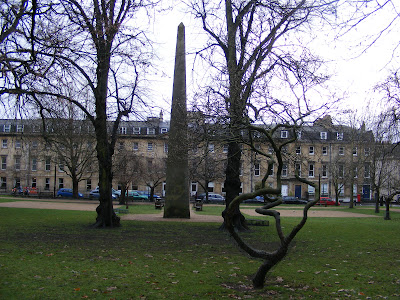One custom during the 17th century was to dip pieces of bread into a glass of wine to improve its flavour [I've seen a couple of young men do this once in a restaurant in Cinque Terre, Italy]. The story is told that during the reign of Charles II, whilst a celebrated beauty was bathing, a spectator stepped forward, dipped his goblet into the water and drank the lady's health. This prompted his lusty companion to jump fully clothed into the bath and declare 'since he liked not the liquor he would have the toast!' From that moment the tradition of toasting a beautiful lady to improve the flavour became the fashion.We walked along quite a bit of Bath that we'd already seen, but the booklet told us things we wouldn't already have known. For example, at Queen's Square,

the Obelisk (that word always makes me think it should be a round object, but of course it is not) there is to mark the visit of Frederick, Prince of Wales, in 1738. The booklet quotes his mother, Queen Caroline as saying,
My dear first-born is the greatest ass, the greatest liar and the greatest beast in the whole world and I heartily wish he was out of it.So much for a mother's love. It made me curious to know more about Frederick.
We learned about the Bath Chair being the demise of the Sedan Chair, though I gather the latter were privately owned and therefore more luxurious; sort of the difference between having a car and taking a taxi. However, less expensive because only one person was required to provide locomotion.
Walcot Street continues along the riverside to the North East of the touristy area of Bath and is apparently the older

-- as in 500 AD -- part of Bath, except that they probably didn't consider themselves part of Aquae Sulis. The book describes and fountain and some vineyards which of course are gone.

This apparently was also the business district and 'Walcot' means 'city of foreigners'. This road becomes London Road which was once the main road into that capitol. Like many other riverside areas in the UK, being so close to industry it became the place for the poor to live. Still, the terraced houses look pretty grand to me.

St. Swithin's church, where Jane Austen's parents were married, can be found here. Along with funny little shops

that had I not travelled via Easy Jet with carry on luggage only, I might have investigated further. I was wishing we had something like The Makery in Newcastle, as I'm desperate to learn to sew better.

Bill and I found lots to photograph. We both liked the front of this building, designed specifically to allow carriages to turn.




No comments:
Post a Comment